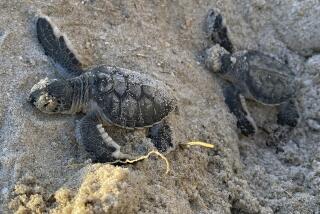Rare Turtles Get Second Chance at Survival in Conservation Project : Ecology: Zoologists salvaged eggs from diamondback terrapins killed by motor vehicles and raised the hatchlings in captivity. Recently, children released the critters into the wild, giving the youngsters a living lesson.
- Share via
STONE HARBOR, N.J. — The freckle-faced kindergarten student reached into a pailful of diamondback terrapins and pulled one out. Gingerly, he stepped to the water’s edge in a saltwater marsh and lowered it in, waving goodby as the turtle entered its own habitat for the first time.
“It felt like he was going to bite me,” 5-year-old Matthew Bridgeman said.
“Now he’s swimming all the way out there,” he said, pointing to the winding river that snakes through the marsh.
After him, 24 other children paraded two by two to the same spot, each releasing a turtle and watching it disappear into the blue waters of the marsh.
The “turtle launch” marked the end of a yearlong conservation effort, the Terrapin Rescue Project, in which zoologists salvaged eggs from diamondbacks killed by motor vehicles, raised the hatchlings in captivity and released them into the wild.
The baby turtles got a second chance at life partly because their mothers didn’t. And the children learned an early lesson in conservation.
“The kids live all around these wetlands and this lets them know that there’s more than tall grass there,” said Cindy Hein, a teacher who accompanied the children. “It makes them aware of the environment at an early age. It’s a good place to start.”
Diamondback terrapins live in salt marshes along the Atlantic and Gulf coasts of the United States.
They are rarely seen. But each year, from early June to mid-July, female terrapins crawl up out of the marshes in search of higher ground to dig nests and lay their eggs.
Many end up as summer’s squashed.
Last summer, Stockton College zoology professor Roger Wood and students under his direction removed eggs from dead females and raised 25 baby turtles in laboratories.
The children got to see the baby turtles when they were the size of a quarter last fall. When they saw them again recently, the turtles were 3 or 4 inches long.
In between, the children baked turtle-shaped cookies and held a raffle for a quilt embossed with turtles to raise money for the project.
David Harlan, 6, presented Wood with a check, the proceeds of which will help pay to raise this year’s batch. “We raised $390 for the baby turtles,” he said shyly, handing an envelope to Wood.
“That’s going to buy a lot of turtle food. That’s going to make a lot of turtles happy this winter,” Wood told the boy.
Moments later, like a Pied Piper of the marsh, Wood led the children down a path and out into the marsh for the launchings, and the giggling children began reaching into the pails to pull out wriggling turtles.
More to Read
Sign up for Essential California
The most important California stories and recommendations in your inbox every morning.
You may occasionally receive promotional content from the Los Angeles Times.













